Unit 3 MIC102
1/69
Earn XP
Name | Mastery | Learn | Test | Matching | Spaced |
|---|
No study sessions yet.
70 Terms

What does a virus consist of?
membrane
nucleic acid
protein shell
Spike protein
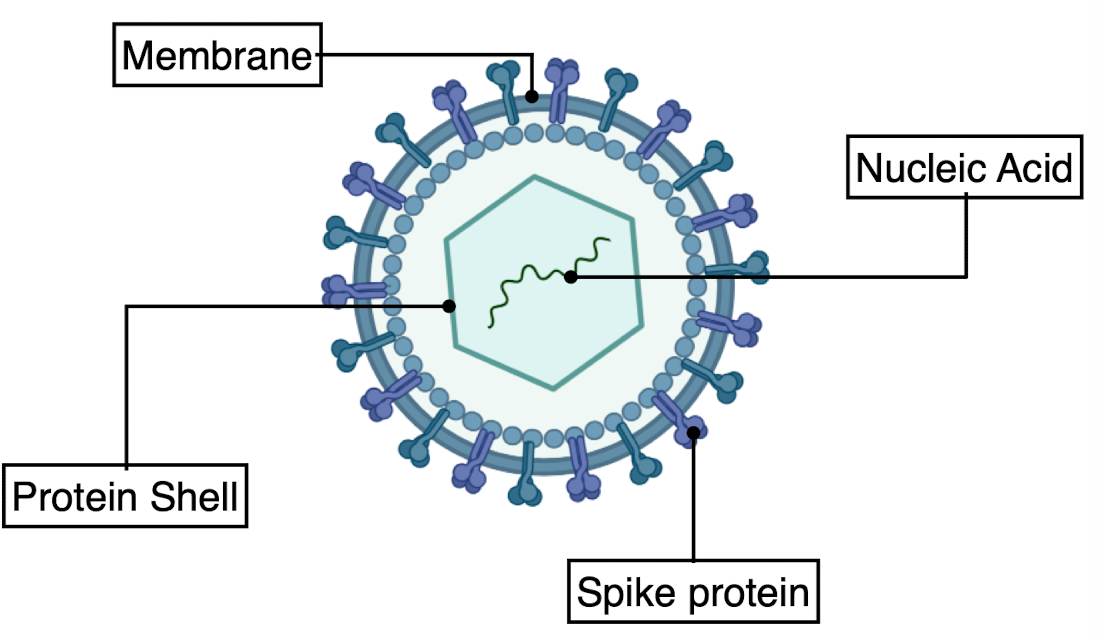
Can viruses infect every type of cell? (bacteria/eukaryotes)
Yes, although viruses have some specificity, they can still infect different organisms or cells
Are there more viruses than hosts?
Yes, 1031 total viruses and are the largest reservoir for genetic diversity on earth (more viruses than stars)
What is a virus and what do they lack (2)?
Obligate intracellular parasites that don’t encode all necessary components for their reproduction (must replicate genome in cell of host organism)
Lack complete translation machinery
Lack complete energy generation machinery
Not all viruses cause disease and can be beneficial to the host. Name 5 examples and how they’re beneficial.
Vibrio cholera: requires infection by bacteriophage, which carry toxins for gut invasion
Mouse herpes virus infection: can protect against bubonic plaque
Cucumber Mosaic Virus (CMV): improves drought tolerance in plants
White clover mosaic virus: repels fungus gnats
Protists: serve as a source of nutrition
Healthy adults have more than __ types of virus infecting
5
What are the viral origins of how you were born?
Placentation arose from horizontal gene transfer from retroviruses
Syncytiotrophoblasts involved in placental formation use a viral protein syncytin
(note: syncytiotrophoblasts are proteins from viral organs that promotes cells to get together and get multinucleated cells that helps in forming placenta)
What are the 5 main steps to the viral life cycle?
translation and replication
packaging and assembly
exit
free virus
attachment
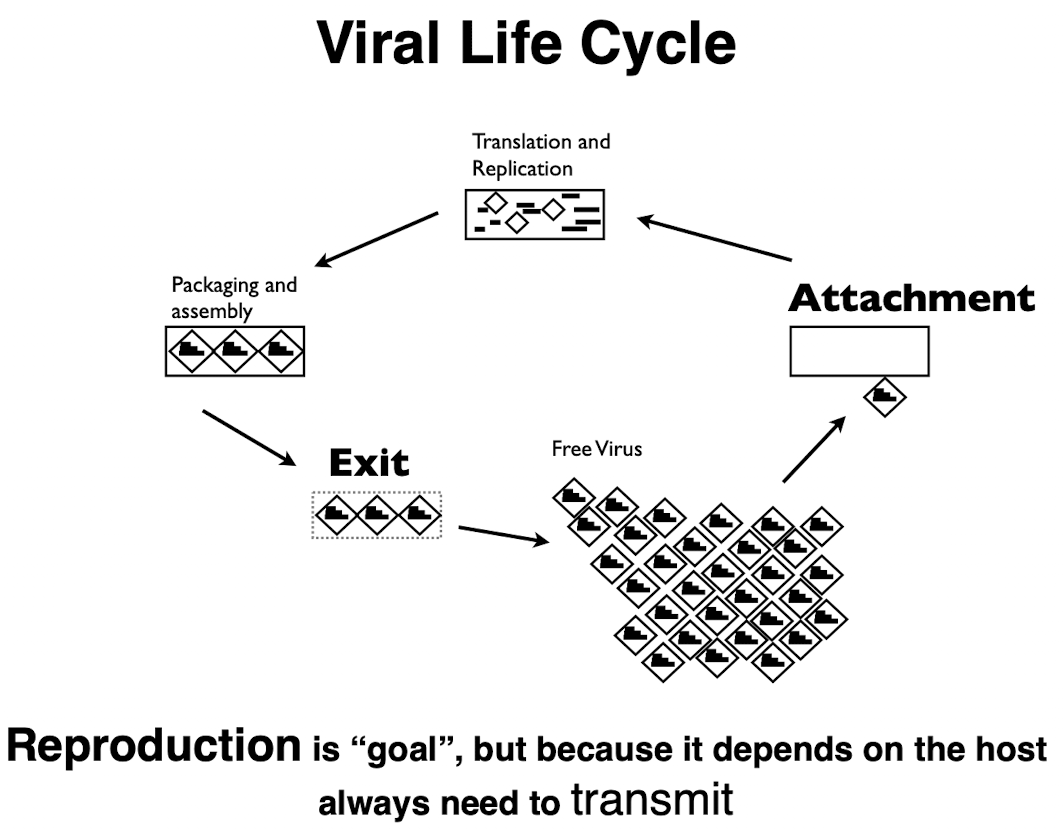
What are the two primary activities viruses need to accomplish within the cell?
Transcription of their viral proteins, and replication of their viral genome
These activities are completed with a mix of viral and host proteins and enzymes
Sometimes viruses encode their own enzymes and could in theory use the host’s
Why is it difficult to classify viruses based on genes?
There is no universal gene shared among viruses such as ribosomal RNA
Why is hard to find conserved regions in viral genomes?
Viral genomes evolve rapidly, making it difficult to find conserved regions and nucleotide not under selection
How are most viruses classified?
Most virologists classify viruses according to their nucleic acids using the Baltimore Classification
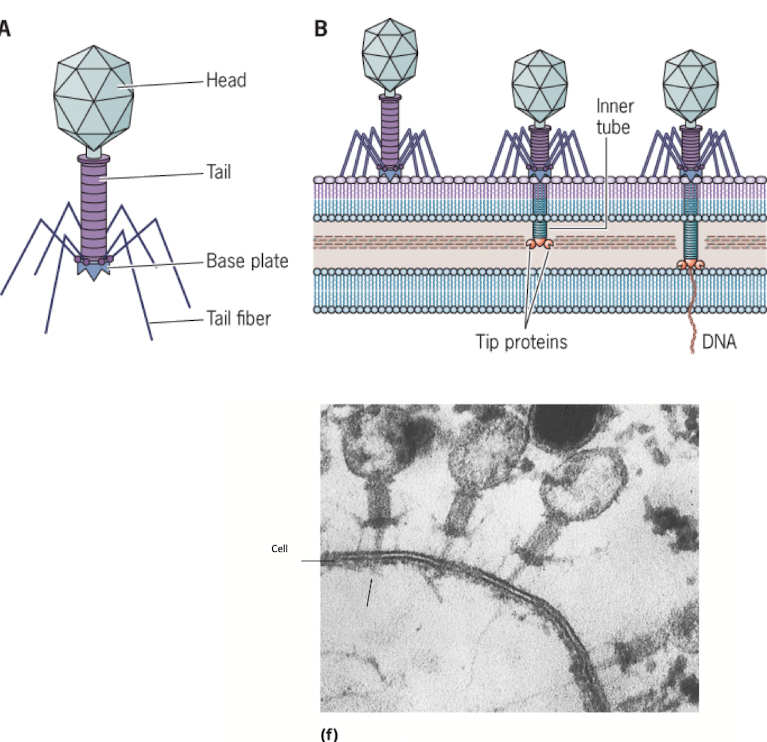
T4 phage
Tip proteins degrade peptidoglycan and allow ejection of DNA into host

dsDNA virus replication
Circularizes inside the cell
Rolling-circle replication style is possible/likely
genome copies packed into capsid
ssDNA (+) virus replication
(+) ssDNA acts as template to make (-) strand
dsDNA molecule available for transcription
dsDNA (-) strand available to synthesize more (+) strand for genome
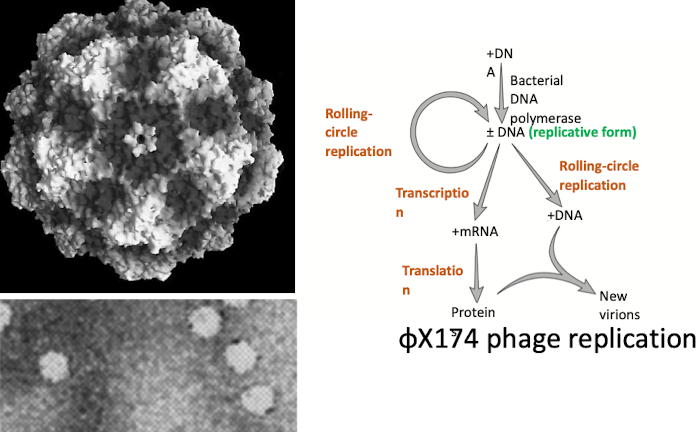
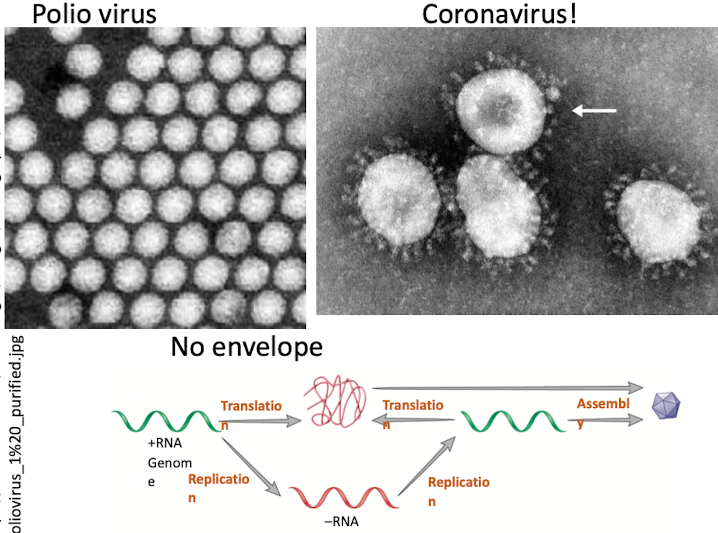
ssRNA (+) replication
Sense strand ready for translation
Viral RNA encodes and RNA replicase (creates (-) template then use that to replicate (+) strand)
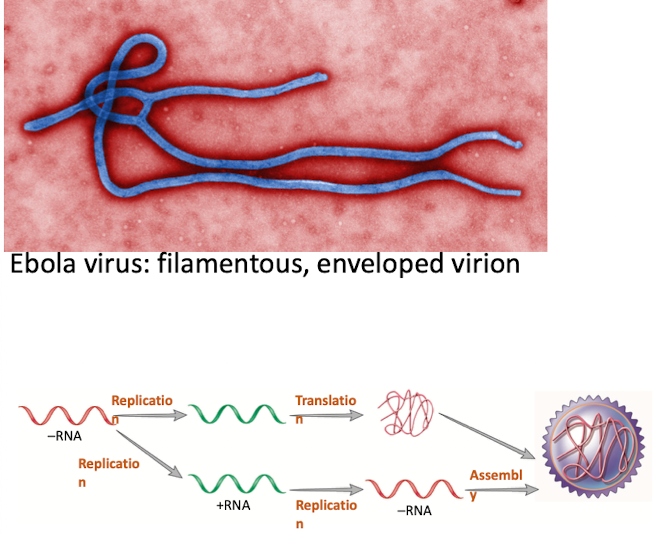
ssRNA (-) virus replication
Contains a prepackaged RNA replicase; (-) RNA not immediately useable for translation
RNA molecule is often attached to the capsid to keep it accessible to the replicase
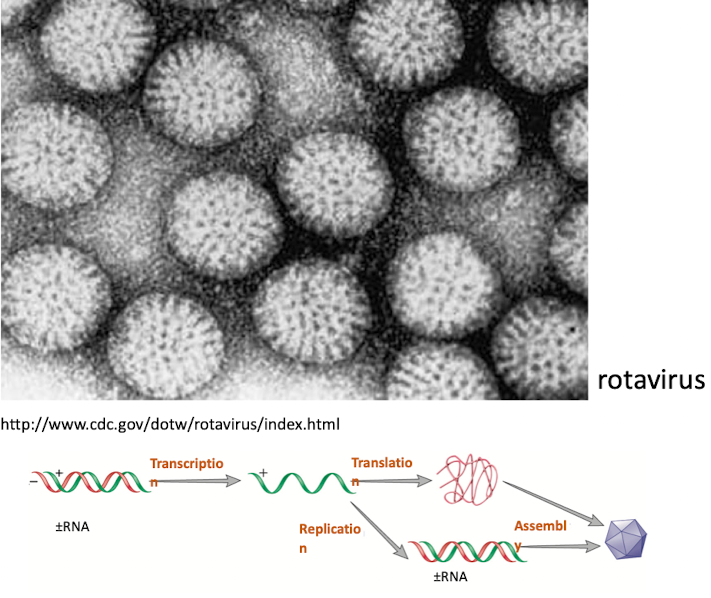
dsRNA replication
viral replicase is included in virion
generates (+) strand RNA for translation
Replicates both strands for genome replication

Retrovirus replication
(+) ssRNA
Prepackaged viral reverse transcriptase generates a (-) ssDNA
(-) ssDNA is template for (+) strand DNA
dsDNA is integrates into host genome using an integrate encoded by virus
Host RNA polymerase transcribes new viral genomes off this integrates dsDNA
What is the eclipse period in viral protein synthesis?
The period after genome insertion and before vision completion when no viral particles are detectable
What must happen if a virus in not (+) RNA?
mRNA must be transcribed
What is the role of early proteins in adenovirus replication?
Early proteins direct the cell to replicate viral DNA and make later proteins
When are completed intracellular virus particles formed in adenovirus?
When DNA and late proteins are assembled
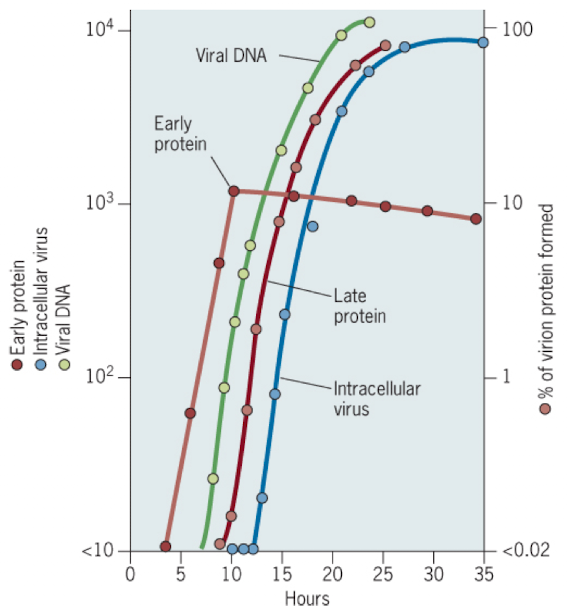
Packaging and Exit from the Cell Process
capsids are formed through capsomer self-assembly
nucleic acids packaged into completed capsids
capsids complete, non-enveloped virus ready for exit
Enveloped circuses bud off from host cell

Why are viral processes good targets for antiviral drugs?
Many viral processes are unique to viruses, making them effective targets for drugs
What is the best practice to avoid antiviral drug resistance?
Use multiple different types of drugs when possible
What. is viral latency?
A state where the virus is inside the host cell but does not proliferate or damage the cell
What are the two main ways viruses can maintain latency?
Episome: Viral DNA maintained as an extrachromosomal element (varicella zoster)
Prophage/Provirus: viral genome integrated into the host chromosome
What must viruses do to maintain latency?
Avoid host cell destruction
Avoid activating viral replication
What can cause a virus to reactivate from latency?
Stress, immunological suppression, or physiological changes in the host
What can latency do to the host?
Protection from other infections
Chronic diseases
Cancer (cell transformation, regulatory sequences)
Endogenous retrovirus
What type of genome does λ phage have ?
double-stranded DNA (dsDNA)
How does λ phage DNA circularize upon entry into the host cell?
Using sticky ends, DNA ligase joins them
Circularization protects viral DNA from host exonuclease
Where does λ phage integrate into the host chromosome?
at the attB site
Selective Toxicity
Antibiotics are primarily toxic to bacteria but not eukaryotes
Spectrum of Activity
How many types of bacteria an antibiotic is effective on
Bacteriostatic
inhibit
bacteriocidal
kill
How do we measure susceptibility?
Through minimal inhibitory concentration: the lowest concentration of a drug that will prevent the growth of an organism
Kirby Bauer Assay makes testing many antibiotics at once easy
How does bacteria develop resistance in penicillin?
Through beta lactamase enzymes
How do antibiotics work?
Attack bacterial target necessary for cell function
cell wall
cell membrane
DNA synthesis
RNA synthesis
Protein Synthesis
Metabolism
What are the 4 main categories of antibiotic resistance mechanisms?
Alter target (ex. mutations in PBPs stop methicillin from binding)
Degrade antibiotic (ex. beta-lactamase cuts open penicillins)
Modify Antibiotic (ex. adding methyl, acetylene, hydroxyl groups to kanamycin)
Remove antibiotic from cell (ex. multi drug transport NorA in S. aureus)
Why are multidrug exporters a growing problem?
One multi drug resistance (MDR) efflux pump can provide resistance to many different types of antibiotics
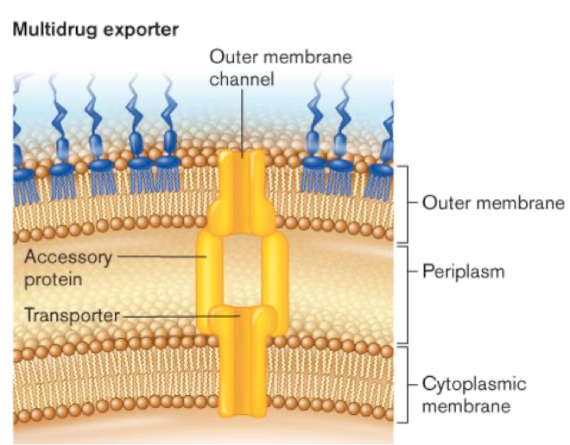
How are multi drug exporters similar to ABC transporters?
They function similarly but are usually powered by the proton motive force (PMF) instead of ATP
Why can bacteria develop drug resistance quickly?
Bacteria are efficient at evolving new functions and can transfer resistance genes between cells
What is the typical rate of spontaneous resistance to a given antibiotic?
Approx 1 cell in 107
What mechanisms allow bacteria to transfer resistance genes?
Conjugation
Insertion elements
Transduction
How can using multiply-linked antibiotics help delay resistance?
Developing resistance to two drugs at once is much harder than to one, though still possible with MDRs
Airborne (bacterial diseases: modes of transmission)
inhalation of infectious particles leading to infection of respiratory tract
Diphtheria and it’s symptoms (airborne)
Diphtheria toxin is absorbed by circulatory system and inhibits protein synthesis in cardiac, kidney, and nervous tissues
Symptoms include nasal discharge, pseudomembrane forms, fever, cough, paralysis
Vaccines consist of inactivated toxin and is effective
What are some examples of mycobacterium (airborne)
Bacteria with use mycotic acids in cell walls: acid-fast
M. avian complex (most common pathogen group in U.S.)
M. tuberculosis (M.bovis and M. africanum) causes tuberculosis
Infects macrophages
What are some treatments of tuberculosis?
combination of antibiotic therapy
Multidrug resistant Mtb have been found
Skin tests for reaction from sensitized T cells by injecting a purified protein derivative
Arthropod-borne (bacterial diseases: modes of transmission)
Insects are common vectors; not common for bacteria as viruses and protists
What is Lyme disease? (arthropod-borne)
tick-borne transmission of spirochete Borrelia
Rodents and other wild animals natural hosts
Initial symptom of target -shaped skin lesion and flu-like symptoms with second stage including neurological effects, heart inflammation, arthritis
Plague (arthropod-borne)
caused by Yersinia pestis that spreads by fleas from animal to animal, direct contact, and airborne person to person
Multiplies in vlood and lymph rapidly once in body
Symptoms include hemorrhage, fever, headache, exhaustion, extreme lymph node swelling
Direct Contact (Bacterial diseases: modes of transmission)
transfer of bacteria to/from skin, underlying tissue, mucous membranes
STIs are common forms of disease spread
Chlamydia (direct contact)
Asymptomatic carriers
Symptoms include burning feeling, discharge and can spread and create pelvic inflammatory disease
Gonorrhea (direct contact)
Infects mucous membranes of genitourinary tract, eye, etc
Use pili and surface protein to adhere to microvilli of mucosal cells
Symptoms include painful urination, yellow pus, frequent urination
Staphlyoccus infections (direct contact)
normal inhabitants of skin, upper respiratory tract, intestine; pus-forming (pyogenic)
Staph tends to cause disease due to its rapid growth and toxin production
Food/water contamination (bacterial disease: modes of transmission)
commonly cause E. coli gastroenteritis
Symptoms include: diarrhea, inflammation (gastroenteritis), fever
E. coli is common and most strains are harmless/commensal
Opportunistic infection
microbes can come from our microbiome or from environment
Typically only cause disease in immune-compromised hosts
Antibiotic-associated colitis (opportunistic infections)
Clostridium difficile: normal gut microbe
antibiotic treatment can upset gut microbiome balance, allowing C. dif to flourish, leading to diarrhea, colitis, due to constant inflammation and cell death
Influenza Virus
Multiple (-) RNA strands
Enveloped
Relatively sensitive to heat, drying, acid
What are the two important envelope proteins in influenza virus?
Hemagglutinin (H): causes RBCs to stick together, used to bind target cells
Neuraminidase (N): cleaves sugars that bind viral particles, in order to facilate exit
Antigenic Drift (viral evolution)
minor changes in H and N proteins
Tend to cause minor epidemics every 2 years
mutations in H and N make flu virus slightly harder
Antigenic Shift (viral evolution)
Major changes to H and N proteins
Tend to cause pandemics every decade
Caused by reassortment of H and N proteins
HIV/AIDS: how does it spread
Human Immunodeficiency Virus (+RNA retrovirus)
Spread through direct contact with blood, breastmilk, or sexual fluids
Untreated HIV leads to Acquired Immunodeficiency Syndrome (AIDS)
What does HIV consist of?
Enveloped virus
2 copies of RNA genome
Viral spike proteins help attach to susceptible host T-helper cells
gp120 protein allow binding to CD4 receptor
How does HIV enter and work inside the body?
HIV enters through endocytosis
Uncoating and reverse transcription of genome into DNA
Integrase inserts genome into host chromosome
Integrated virus can replicate slowly over time